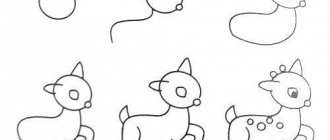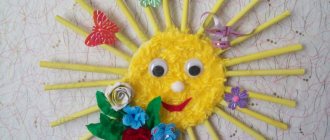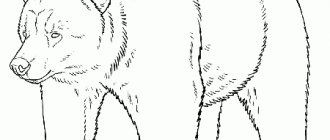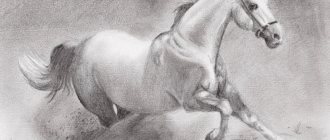Summary of OD in the senior drawing group “Fluffy Animals”
Irina Serikova
Summary of OD in the senior drawing group “Furry Animals”
1. Teach children to create an expressive image of a kitten using painting techniques with a dry brush or a “broom”
.
2. Continue learning to draw animals in motion .
3. To consolidate children’s knowledge about the work of illustrator E. I. Charushin.
4. Improve your skills in working with gouache.
5. Foster a caring attitude towards animals.
6. Develop articulatory motor skills.
Materials for the lesson:
•Demonstration: books with illustrations by E. I. Charushin
•Handout: tinted A4 paper, gouache, bristle brushes, thin brush, broom branches, napkins, oilcloths.
• Preliminary work Reading the stories of E.I. Charushin, looking at the illustrations for them.
1. Magazine “Child in kindergarten”
3-2002
Necessary materials
In the first stages of learning to draw, you need the simplest supplies, paper and a simple pencil. It is easier to learn to draw with a simple pencil; it is also used to create preliminary sketches and sketches.
Children will be happy to color a pencil drawing with paints, and if at first something doesn’t work out, the drawing can easily be corrected with an eraser.
It is better to choose a pencil marked TM or HB, i.e. neither hard nor soft, medium. It is better to take landscape paper; notebook sheets in a cage or a ruler distract the child.
Preview:
Topic: “These funny animals.”
- To acquaint children with the features of the animalistic genre, to define the concept of “artist – animalist”.
- Expand children's understanding of the work of the writer and artist E. I. Charushin.
- Teach children to depict animal fur using strokes, showing the features of stroke movements when creating an image.
1.Develop technical skills in working with graphic materials.
2.Improve the ability to depict animals using a diagram.
3.Develop creative thinking, imagination, speech activity, communication skills.
1. Cultivate a love for animals.
Equipment: Sandpaper, crayons.
Methodological material: presentation, methodological tables, sample work.
I. Organizational moment.
In one city there lived a little boy, Zhenya. He loved animals very much.
Many different animals lived in the house. It was a real home zoo. In the yard lived piglets, turkey poults, rabbits, chickens, kittens and all kinds of birds - goldfinches, siskins, waxwings. Cats lived in the house, cages with birds hung on the windows, and there were aquariums and jars with fish.
Zhenya not only loved animals, he cared for them, observed them, and also drew them.
The boy Zhenya grew up and became a wonderful artist and animal painter.
II. Conversation during the lesson.
— Guys, do you know who animal artists are?
-Let's take a trip through the pages of children's books and see.
-What do animal artists draw?
Well, let's go on a trip.
1 slide. -Guys, here is a portrait of the animal painter E. Charushin.
2 slide. – These are drawings from children's books drawn by E. Charushin.
- Guys, what do animal artists draw?
Animal artists paint animals.
An artist who draws animals is called an animalist.
3 slide. – Illustration for the story “The Little Wolf”.
-Do you like this little wolf?
-And why? (He is small, nice, looks like a puppy)
-What can you say about the wolf cub? (ears stick out, tail tucked)
The artist shows that the wolf cub is terribly uncomfortable in the forest.
4 slide. - “Bear cubs.”
-Look how funny the bear cubs are. The artist painted them so that we see soft ears, shaggy fur, serious faces and soft paws. One diligently sucks milk from a bottle.
- What can you say about the other? (He also wants milk and this will go either way).
— And here we see cubs on the roof of the house.
-What can you say about these cubs? (They carefully examine the brick that lies on the roof. The artist depicts one bear cub on its hind legs. The muzzle is elongated, surprised.
-What can you say about the other?
5 slide. – Here we see Tyupa hunting for a bird.
And this is Tomka. How funny and cute they are.
6 slide. – The artist depicts animal cubs that are fluffy, soft and completely helpless.
— Guys, did you pay attention to the fur of animals?
- What is it like for them?
— To draw fluffy fur, the artist uses his own techniques.
— Do you want to learn how to draw fluffy, funny animals?
-What materials can be used to draw fluffy fur?
-You can depict it in gouache or watercolor, as E. Charushin did, but you can also depict it with pencils and crayons.
Early in the morning from far away
Magpies flew to us (crossed hands, imitation of flight)
They began to chatter loudly (fist on fist three)
Wave a long tail (palms close to each other and tilt left to right)
They pecked the grains (Hands peck and peck)
Everything in the world was told. (Clench and unclench your fists)
V. Explanation of the material.
Today we will get acquainted with a new unconventional technique. And we will draw not on a sheet of paper, but on an unusual material.
-Maybe you know what kind of material this is. Look, touch it.
This is sandpaper.
-You and I are good at drawing pets.
And today this will be very useful to you. And I’ll tell you how, knowing how to draw pets, you can learn to draw other animals.
- Here's your first clue.
1. Find the differences between a kitten and a tiger cub. (Ears, color, tail).
2. Find the differences between a kitten and a lion cub. (Ears, color, tail, mane).
Conclusion: Knowing how to draw a cat, you can draw a lion, tiger, panther and other animals.
- Where do we start work? From the diagram.
-The animal can be depicted in motion, or lying down. Look at the diagrams.
- Now think about what animal you will draw.
-Let's get to work.
-Guys, you drew the outline. Now you need to draw the fur. Look how I will do it. I choose a color and paint it with small strokes. Adding different shades.
Source
Sequence of work
To decide on the sequence of work, you can watch several master classes on the topic “How to draw an animal with a pencil.” Step-by-step instructions for beginners may be something like the following.
First you need to choose the animal that you plan to draw. The figure should consist of a small number of simple geometric shapes. For example, duck. A duck can be “made up” of two ovals. The oval head and the larger oval body are connected by two lines called the neck.
From the large oval you need to draw small lines with elongated triangles - these will be webbed feet. In order to shape the duck's tail, you need to slightly sharpen the larger oval. Next, an arc is drawn on the body - this will be the wing. Eyes and beak are drawn on the head.
Such step-by-step instructions on how to draw animals are, of course, significantly simplified. One rule should be learned: the animal must be “decomposed” into simple geometric shapes, and by connecting them, draw the intended animal.
For many animals, the number 8 can be a suitable basis. Insects, bees, spiders, and butterflies are often drawn on the basis of the number eight. The figure eight is designed in accordance with the idea: the upper part is narrower, wider, more or less elongated. Next, the workpiece is “overgrown” with wings, legs, and antennae.There are some other tricks on how to easily draw an animal. For example, a circle is taken as a basis. Then it is supplemented with ears and a beak. The torso is drawn in accordance with the intended image. The paws and tail are located on it.
Children especially love to fill their drawings with emotional coloring. Therefore, most likely, hares, foxes, even wolves in children's drawings will smile. You should not prohibit your son or daughter from creating such “unrealistic” drawings: this is one of the features of a child’s perception of the world around him.
Older children will be able to create a composition from several animals and supplement it with appropriate images of flowers and trees.








